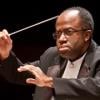
Friday night at the San Francisco Symphony, with the Oakland Symphony’s Michael Morgan on the podium, and Davies Hall (almost) full of excited fans! A big part of the vibe were the actual (acoustic) vibrations. For myself, and I’d guess many others, this was the first chance to hear a full orchestra in a year and half. It was an enormous difference to listen live — palpably exciting from the very first moment, when the snares snapped out their drum rolls to open the Overture from La gazza ladra, that dazzling Rossini chestnut. Yes, snare drums plural: Although the score only calls for one, we got snares in stereo. If this thieving magpie hopped around at a somewhat overleisurely pace, the upside was a chance to savor the precision trills and explosive arpeggios in the strings, sounding as tight an ensemble as if they’d been playing together all year.
A second Rossini hors d’oeuvre was the Pas de Six from William Tell, a nimble piece of ballet music with an upbeat theme gracefully danced by the first violins and a fine solo by associate principal oboe James Button.

The Third Symphony of French composer Louise Farrenc was the “serious” piece of the evening. As Morgan pointed out, Farrenc — the first woman to be professor of piano at the Paris Conservatory — is best known for her chamber music, but her symphonies were also much admired in the mid-19th century. And with good reason, judging from this performance.
Rich and varied in tonal color, confident and clear in structure, Farrenc’s symphony should be better known. (Morgan has been making the case before, in performances with the Oakland Symphony in 2019.) It is accessible and innovative. Its four-movement form places it in a camp with Mendelssohn and Schumann. But within that familiar framework is a wealth of distinctive, individualistic touches.
The first movement is the most profound, a passionate journey in the dark key of G minor, with a tragic feel, full of expressive syncopations, heightened by plangent sighing figures (descending minor seconds), and leavened by sensitive changes in tone color. Some recurring episodes employ the “crunchy” suspensions beloved by composers of the 17th century — a reminder that Farrenc was one of the first serious scholars of what we now call “early music,” teaching and researching historically-informed performance practice.
The second movement is lyrical, with a cantabile melody, which Farrenc develops not so much by ornamenting as with ample variation and lush elongations. The Scherzo is snappy, full of fast violin trills and a lovely exchange between flute and bassoon. The Finale mixes playful wind playing with a craggy and angular fughetto.

To end the program, Morgan chose an orchestral arrangement of Charleston by the mid-20th-century African American composer andy pianist James P. Johnson. Talk about expressive syncopations! The jazzy Charleston rhythm rocked the hall, with splendid solos from the back of the stage — on trumpet, clarinet, trombone, piano, and finally drum set.
Morgan’s choices of music were perfectly tailored to the 75-minute, no-intermission format. Shorter concerts have been forced on us by the pandemic, but I hope they become more of a standard in the future, or at least an alternative to the longer form. I hope, too, that more conductors address the audience between pieces, as Morgan did with genial and witty grace.
Finally, it was a joy to see Morgan at the podium in Davies Hall, his long-overdue conducting debut with the orchestra. He was slated for subscription concerts in spring 2020, inevitably canceled but which he’ll pick up in February 2022. The SF Symphony is finally giving the stage to a conductor who’s been across the Bay for 30 years. This past summer, Morgan was presenting episodes in SF Symphony’s CURRENTS series — a sign, I hope, that this orchestra is on the path to creating a more inclusive world for classical music.




